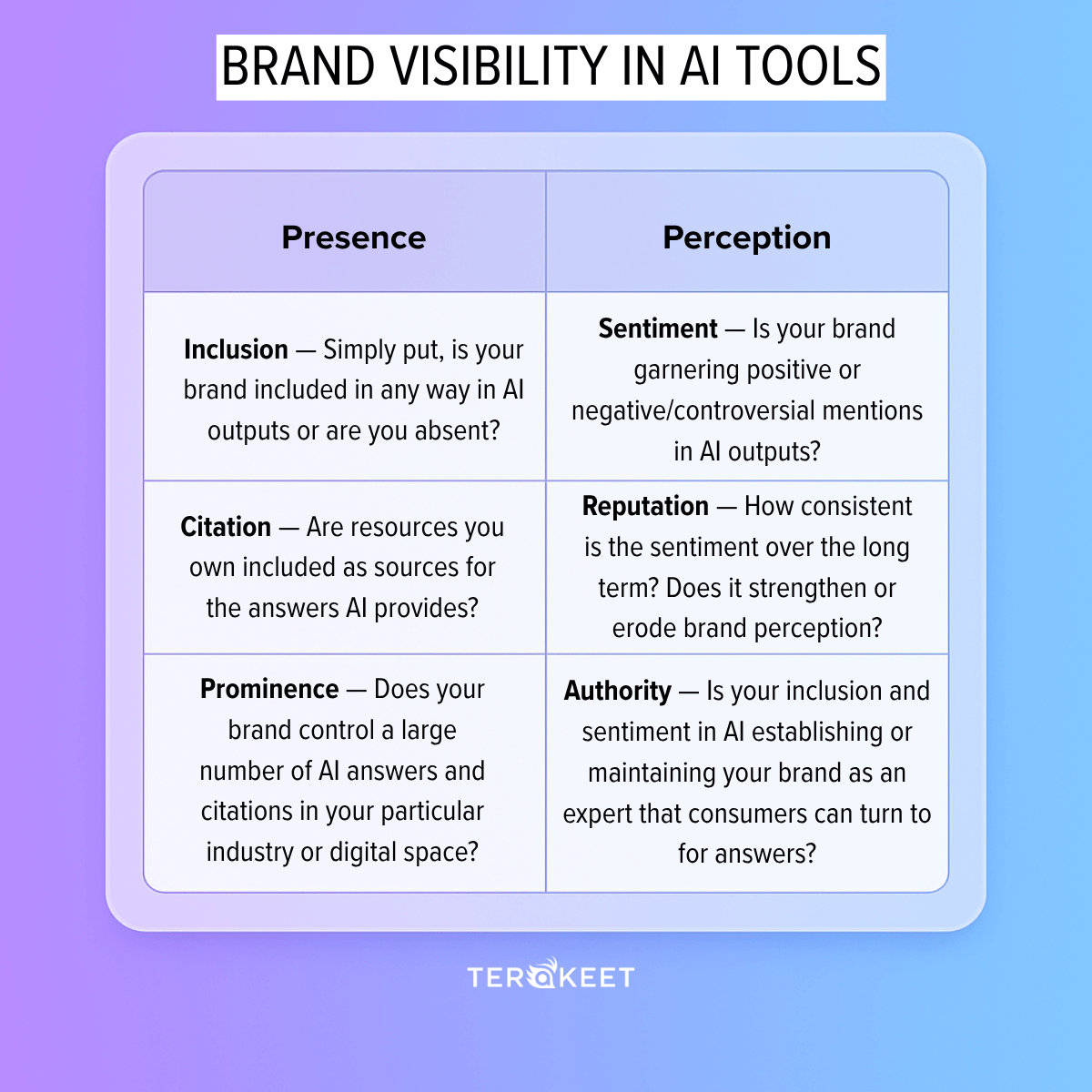
Why Brand Visibility Is The AI Era’s Performance Metric
Jun 6, 2025|Read time: 6 min.
Key Points
- The AI-centric customer journey challenges marketing assumptions and it’s time for brands to make visibility as a top priority.
- Why the metric change? Because AI tools changed consumer behavior and because the crystal clear metrics brands relied upon aren’t quite as reliable anymore.
- Visibility allows marketers to keep measuring value while moving from clicks and traffic to influence, relevance, and trust in AI tools and beyond.
Before the internet, marketers relied on methods that delivered near-zero performance data. A billboard went up, a TV spot was placed, or a newspaper ad was used. It was an impressions-only model.
The internet and platforms like Google Search Console and Google Analytics injected much-needed metrics and transparency into marketing. Attribution models provided performance metrics of brand content, and brands tracked performance through clicks and traffic.
The rise of Large Language Models (LLMs) feels like a step back into the impression-only days. The ‘Google generation’ metrics and attribution models are in flux because AI has changed the buyer’s journey.
Consumers are spending more time in AI search like Perplexity or ChatGPT and less time in the more trackable places like organic search, brand blogs, and landing pages.
Trending away from traffic
So, where does that leave us today? Moving away from the old metrics.
It’s time for brands to transition from click and traffic metrics to visibility-focused measurement and impact. Consumers are rapidly adopting AI solutions, often replacing how they used to search. Brands need to be prepared for zero-click searches.
In 2024, Google’s VP of Search, Elizabeth Reid, referred to AI Overviews as a tool capable of “letting Google do the Googling for you.” In 2025 at Google I/O, Google’s CEO, Sundar Pichai, called AI Mode in Search “a total reimagining of search.”
Ahrefs recently analyzed 300,000 keywords and found a 34.5% dip in average clickthrough rate (CTR) for the top-ranking pages when an AI Overviews answer appeared on the page. And according to our research, when brands are included in AI Overviews answers, they receive significantly more clicks than those that are excluded. That’s why visibility matters now.
What do we mean by visibility?
Brand visibility is a big-picture measurement of not just brand presence, but also brand perception in the answers and sources AI tools provide.
At a high level, brand presence measures how much you’re showing up and how often you’re included in AI answers, and brand perception speaks to how your brand is being described, positioned, and interpreted within those answers.
We can break this down into a few categories and subcategories.

The above early-stage measures reveal how your brand is performing in the visibility context, but there’s much work to be done to refine and include additional factors. It’s about moving from clicks and traffic to influence, relevance, and trust.
Brand reputation risks
Of special note in the table above is the reputational aspect of perception. In the AI era, brands face reputational harm if inaccurate or controversial content is distributed by AI tools.
Brand marketers shouldn’t forget about this piece, especially when AI is capable of spreading damaging narratives at breakneck speeds to a massive audience.
The value of visibility
The value of visibility depends on the type. Placements are not created equal and many of the most important spots no longer deliver value. Before AI, featured snippets and People Also Ask represented top real estate for brands.
Today, in a SERP with an AI Overviews answer, the value of ranking in the top 10 declines because the user is likely finding their answer from AI instead of scrolling. That’s why brands must prioritize AI placements, whether a citation or content, to benefit.
The overall trend is brand value concentrating in AI answers and tools. And with Google’s AI Mode, an emerging core product outside of the traditional “ten blue links” model, that trend is even clearer.
Tracking AI brand visibility
There are several emerging metrics that brands can begin with for early-stage tracking. These are some of the metrics that Terakeet is using to measure our impact. We’re also building proprietary technology to track these signals at scale.
- Citation frequency — Measuring how often your brand, URLs, or domain gets included* as a citation link in an AI answer
- Narrative inclusion — Measuring your brand mentions when users ask AI about your business category
- Sentiment and framing — Assessing the tone and brand perception conveyed in AI-generated responses to consumer queries
- Generative share of voice — Tracking your brand’s presence, frequency, and positioning across AI tools against that of competitors
*This matters because our research shows that inclusion in AIOs boosts traffic by 1.5x for informational queries and 3.2x for transactional queries.
Tracking limitations and challenges
While the foundation for visibility measurement is built, there are some remaining uncertainties and questions that need to be addressed. At its root, the problem is the lack of clear data around clicks, source prioritization, and citations.
Compared to digital marketing channels like organic search, AI tools offer less transparent attribution and user flow data. The limited insight into what determines which sources AI selects is a challenge. There’s also an issue where brand content may be used by AI without getting cited at all.
But this is why we’re constantly developing and running new research and experiments.
Strengthening brand visibility and reputation in AI
The AI-driven shifts necessitate a new mindset for connecting with audiences. As we said earlier, brands simply must be present in AI experiences and adapt to new measurement methods.
To begin transitioning:
- Invest strategically in creating digital assets and content designed for topical authority. In other words, create content that demonstrates your brand’s unique expertise and consistently helps consumers. This aligns your focus on LLMs in order to be included in AI discourse.
- Unify your digital marketing efforts (PR, SEO, content strategy) with data science. When AI expertise is fused with digital marketing, brands gain maximum value from AI while effectively managing their representation in AI tools. It unlocks the potential to positively impact AI narratives with every marketing initiative you undertake.
- Make proactive narrative and reputation management a top priority whether inside or outside the AI context. Brands that obsessively consider reputation form deeper audience connections and are more prepared to manage the AI narrative and risks.
Ultimately, the AI transformation for brands comes down to being part of the LLM knowledge space — understanding it, participating in it, and influencing it. There is no alternative if your goals include connecting with consumers, maintaining your brand narrative, and leading in your industry.
Without a strong foothold and a visibility-centered philosophy, you risk being left out of the conversation, being defined by AI and competitors, and losing your brand narrative to inaccurate or outdated information.




